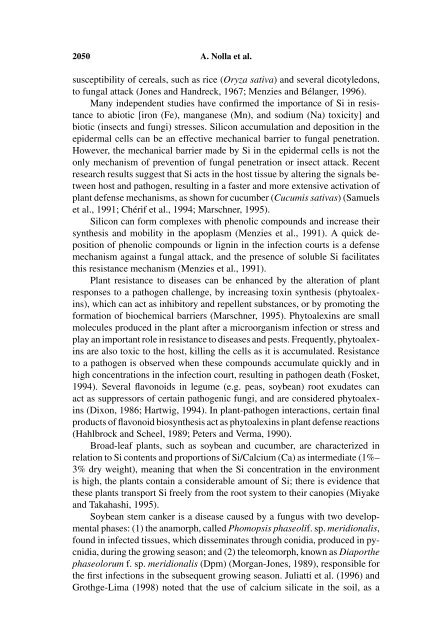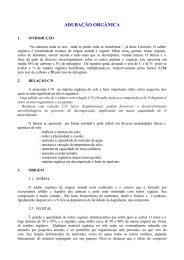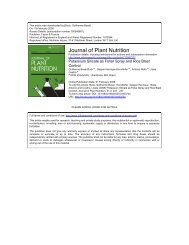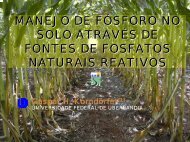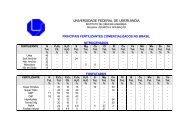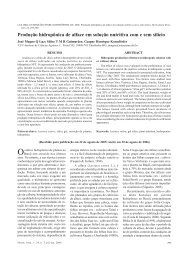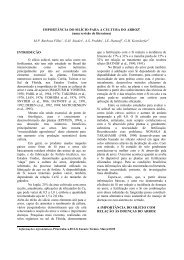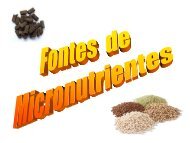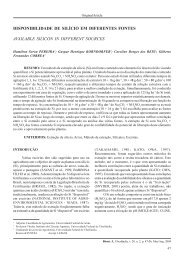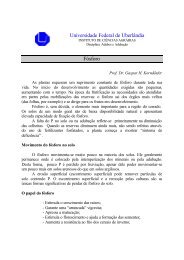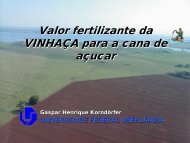Efficiency of Calcium Silicate and Carbonate in Soybean Disease ...
Efficiency of Calcium Silicate and Carbonate in Soybean Disease ...
Efficiency of Calcium Silicate and Carbonate in Soybean Disease ...
- No tags were found...
Create successful ePaper yourself
Turn your PDF publications into a flip-book with our unique Google optimized e-Paper software.
2050 A. Nolla et al.susceptibility <strong>of</strong> cereals, such as rice (Oryza sativa) <strong>and</strong> several dicotyledons,to fungal attack (Jones <strong>and</strong> H<strong>and</strong>reck, 1967; Menzies <strong>and</strong> Bélanger, 1996).Many <strong>in</strong>dependent studies have confirmed the importance <strong>of</strong> Si <strong>in</strong> resistanceto abiotic [iron (Fe), manganese (Mn), <strong>and</strong> sodium (Na) toxicity] <strong>and</strong>biotic (<strong>in</strong>sects <strong>and</strong> fungi) stresses. Silicon accumulation <strong>and</strong> deposition <strong>in</strong> theepidermal cells can be an effective mechanical barrier to fungal penetration.However, the mechanical barrier made by Si <strong>in</strong> the epidermal cells is not theonly mechanism <strong>of</strong> prevention <strong>of</strong> fungal penetration or <strong>in</strong>sect attack. Recentresearch results suggest that Si acts <strong>in</strong> the host tissue by alter<strong>in</strong>g the signals betweenhost <strong>and</strong> pathogen, result<strong>in</strong>g <strong>in</strong> a faster <strong>and</strong> more extensive activation <strong>of</strong>plant defense mechanisms, as shown for cucumber (Cucumis sativas) (Samuelset al., 1991; Chérif et al., 1994; Marschner, 1995).Silicon can form complexes with phenolic compounds <strong>and</strong> <strong>in</strong>crease theirsynthesis <strong>and</strong> mobility <strong>in</strong> the apoplasm (Menzies et al., 1991). A quick deposition<strong>of</strong> phenolic compounds or lign<strong>in</strong> <strong>in</strong> the <strong>in</strong>fection courts is a defensemechanism aga<strong>in</strong>st a fungal attack, <strong>and</strong> the presence <strong>of</strong> soluble Si facilitatesthis resistance mechanism (Menzies et al., 1991).Plant resistance to diseases can be enhanced by the alteration <strong>of</strong> plantresponses to a pathogen challenge, by <strong>in</strong>creas<strong>in</strong>g tox<strong>in</strong> synthesis (phytoalex<strong>in</strong>s),which can act as <strong>in</strong>hibitory <strong>and</strong> repellent substances, or by promot<strong>in</strong>g theformation <strong>of</strong> biochemical barriers (Marschner, 1995). Phytoalex<strong>in</strong>s are smallmolecules produced <strong>in</strong> the plant after a microorganism <strong>in</strong>fection or stress <strong>and</strong>play an important role <strong>in</strong> resistance to diseases <strong>and</strong> pests. Frequently, phytoalex<strong>in</strong>sare also toxic to the host, kill<strong>in</strong>g the cells as it is accumulated. Resistanceto a pathogen is observed when these compounds accumulate quickly <strong>and</strong> <strong>in</strong>high concentrations <strong>in</strong> the <strong>in</strong>fection court, result<strong>in</strong>g <strong>in</strong> pathogen death (Fosket,1994). Several flavonoids <strong>in</strong> legume (e.g. peas, soybean) root exudates canact as suppressors <strong>of</strong> certa<strong>in</strong> pathogenic fungi, <strong>and</strong> are considered phytoalex<strong>in</strong>s(Dixon, 1986; Hartwig, 1994). In plant-pathogen <strong>in</strong>teractions, certa<strong>in</strong> f<strong>in</strong>alproducts <strong>of</strong> flavonoid biosynthesis act as phytoalex<strong>in</strong>s <strong>in</strong> plant defense reactions(Hahlbrock <strong>and</strong> Scheel, 1989; Peters <strong>and</strong> Verma, 1990).Broad-leaf plants, such as soybean <strong>and</strong> cucumber, are characterized <strong>in</strong>relation to Si contents <strong>and</strong> proportions <strong>of</strong> Si/<strong>Calcium</strong> (Ca) as <strong>in</strong>termediate (1%–3% dry weight), mean<strong>in</strong>g that when the Si concentration <strong>in</strong> the environmentis high, the plants conta<strong>in</strong> a considerable amount <strong>of</strong> Si; there is evidence thatthese plants transport Si freely from the root system to their canopies (Miyake<strong>and</strong> Takahashi, 1995).<strong>Soybean</strong> stem canker is a disease caused by a fungus with two developmentalphases: (1) the anamorph, called Phomopsis phaseolif. sp. meridionalis,found <strong>in</strong> <strong>in</strong>fected tissues, which dissem<strong>in</strong>ates through conidia, produced <strong>in</strong> pycnidia,dur<strong>in</strong>g the grow<strong>in</strong>g season; <strong>and</strong> (2) the teleomorph, known as Diaporthephaseolorum f. sp. meridionalis (Dpm) (Morgan-Jones, 1989), responsible forthe first <strong>in</strong>fections <strong>in</strong> the subsequent grow<strong>in</strong>g season. Juliatti et al. (1996) <strong>and</strong>Grothge-Lima (1998) noted that the use <strong>of</strong> calcium silicate <strong>in</strong> the soil, as a


